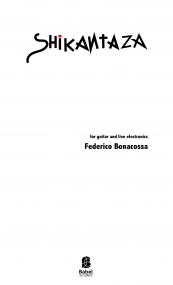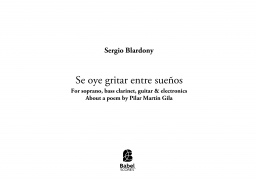Recherche avancée
La desolación está al fondo
For 2 guitars & 1/2 portable speaker/s. Work commissioned by Dúo Arcadia.
9,27 €
Version papier (+14,80 € impression et livraison ). Colissimo7-14 days aprox.
Version numérique (+0,00 €) à télécharger
Chez BabelScores, quand vous achetez une partition, vous pouvez ensuite contacter directement le compositeur ici même !
Caractéristiques
Region
Europe
Estimated Duration
6 - 10min
Date
2018
ISMN : 979-0-2325-3545-6
Notes sur cette pièce The genesis of the work is peculiar. I first imagined a greyish texture coming and going. I wrote a draft. I then immediately thought about how this texture, which is still musically incomplete, evoked some works by the German artist Anselm Kiefer. Specifically, two aspects: as already mentioned, the quality of texture –the importance of matter, the life it entails- and the hopeless depth of many of its "landscapes". An idea of death that calls on the vital as a natural attraction. That space that comes into existence between the blackness of hopelessness –a swaying of the dying- and a dim but defined light (a light bulb, a reflection in the rust), which we don't know whether we're receiving as a breath of hope or simply as a leftover of life. Both aspects seemed to me to make up what could be a "situation outline" –a space of connection with other senses, beyond sound- in which to situate myself in the process of composition of the work.
Specifically, I was impressed by some of the installations in an exhibition at the White Cube in London. One of them was described as follows: "Featuring a long, narrow room lined with oxidised lead, rows of fold-up steel beds are set close together and draped with dark grey crumpled lead sheets and covers. At the far end of the room, a black and white photograph mounted on lead depicts a lone figure walking away into a bleak, wintery landscape. The whole is dark, sombre and sparsely lit by a series of bare light bulbs, suggesting an institutional dormitory, military sleeping quarters or battlefield hospital." Curiously, a similar installation in La Ribotte, Las mujeres de la Revolución (The women of the Revolution) presents a kind of variation of the work described above, but with the beds somewhat tidier and daylight imposed by the bulbs (the entrance to the room is a hole in the wall to suggest the effect of a bombardment). The sensation may be less overwhelming but the evocation of desolation remains intact. The power of the image, of its construction, of the drama set, takes us to the same place: to a very tragic space of our own, to the dramas of our most immediate past. Somewhere I read that Kiefer, through his work (and also the titles he gives to his creations), recognised the possibility of poetry in the midst of devastation (something that inevitably leads us to think of Th. W. Adorno 's so often misinterpreted phrase).
From all these ideas I composed this piece for two guitars where it would seem that nothing happens because only the dregs of the disaster remain. It is from these that the poetic emanates, like a thin line of sound of a simplicity that overwhelms when confronted with time, with what is already past, what has already been heard. A line that wants to be a compressed representation of the disaster while at the same time constituting the beginning of something else, something that I think I can sense in these words of Kiefer:
“(Ruins) for me, are not an end, but a beginning. I love seeing a tower whose cornerstone has been removed, ponder whether it will fall, hesitate; then a rush follows and then a great roar to the ground.”
Sergio Blardony Madrid, January, 2019
Ajouter à une playlist
- Identifiez-vous pour créer une liste
Specifically, I was impressed by some of the installations in an exhibition at the White Cube in London. One of them was described as follows: "Featuring a long, narrow room lined with oxidised lead, rows of fold-up steel beds are set close together and draped with dark grey crumpled lead sheets and covers. At the far end of the room, a black and white photograph mounted on lead depicts a lone figure walking away into a bleak, wintery landscape. The whole is dark, sombre and sparsely lit by a series of bare light bulbs, suggesting an institutional dormitory, military sleeping quarters or battlefield hospital." Curiously, a similar installation in La Ribotte, Las mujeres de la Revolución (The women of the Revolution) presents a kind of variation of the work described above, but with the beds somewhat tidier and daylight imposed by the bulbs (the entrance to the room is a hole in the wall to suggest the effect of a bombardment). The sensation may be less overwhelming but the evocation of desolation remains intact. The power of the image, of its construction, of the drama set, takes us to the same place: to a very tragic space of our own, to the dramas of our most immediate past. Somewhere I read that Kiefer, through his work (and also the titles he gives to his creations), recognised the possibility of poetry in the midst of devastation (something that inevitably leads us to think of Th. W. Adorno 's so often misinterpreted phrase).
From all these ideas I composed this piece for two guitars where it would seem that nothing happens because only the dregs of the disaster remain. It is from these that the poetic emanates, like a thin line of sound of a simplicity that overwhelms when confronted with time, with what is already past, what has already been heard. A line that wants to be a compressed representation of the disaster while at the same time constituting the beginning of something else, something that I think I can sense in these words of Kiefer:
“(Ruins) for me, are not an end, but a beginning. I love seeing a tower whose cornerstone has been removed, ponder whether it will fall, hesitate; then a rush follows and then a great roar to the ground.”
Sergio Blardony Madrid, January, 2019
Instrumentation
Acoustic Guitar|Real-time electronics
Score Details
Format - A4 / US Letter
Pages - 28
Pages - 28









